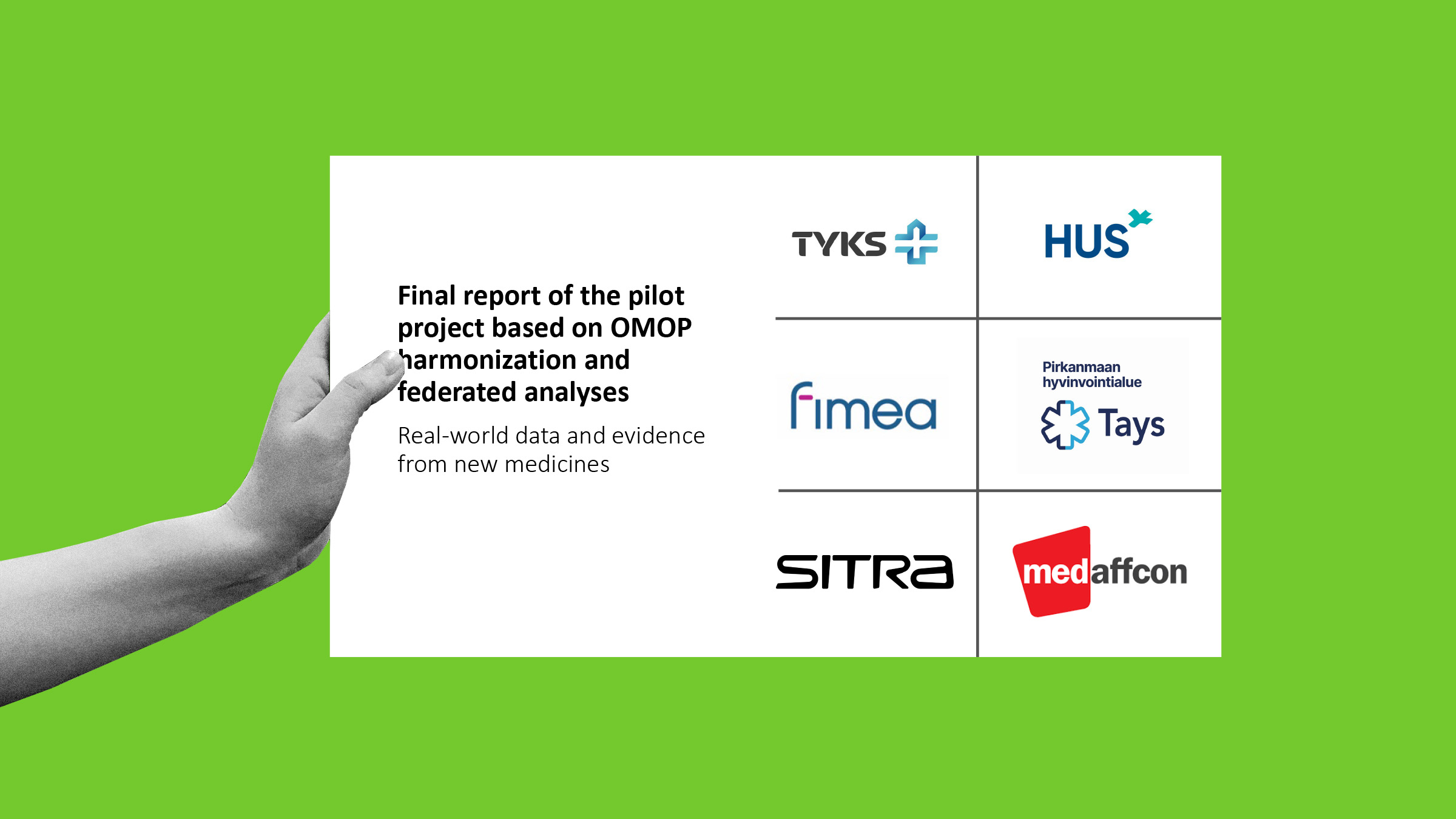Summary
Implementation
- The key participants in the pilot were OMOP centres belonging to the FinOMOP consortium, members of the analytics team, clinical experts, and Finnish Medicines Agency Fimea as the client requesting data for evidence needs specific to HTA.
- Data was requested for three case examples: (1) treatment for multiple myeloma, (2) CAR-T treatments, (3) treatments for SMA (spinal muscular atrophy).
- The OMOP centres used the OMOP databases of three university hospitals and delivered the extracted and aggregated statistical data to Fimea.
- Sitra funded the work of the OMOP centres and the analytics team as part of the broader Health Data 2030 project.
Key results
- A 10-step operating model was used in the pilot project.
- Not all data requested by Fimea was stored in the OMOP databases. The centres standardised the missing data into the OMOP Common Data Model (OMOP CDM).
- The most time-consuming steps were the standardisation of missing data and the centres’ contract processes, as well as the evaluation of the quality of the extracted data.
- The OMOP centres provided Fimea with anonymous aggregated, centre-specific results for each case example separately. Before the data was provided to Fimea, Finnish Social and Health Data Permit Authority Findata verified the anonymity of the results.
- Findata was also asked for guidance for producing anonymous results. According to Findata, the results from aggregated statistical data should be masked when there are 1–3 observations.
- Fimea pooled the centre-specific results and evaluated the usability of the statistical data from the perspective of HTA related evidence needs. The evaluation used a classification: usable, partially usable, not available/unusable.
Key observations
- For the first time, OMOP databases were used in a joint pilot between the FinOMOP consortium and Fimea, representing a client. The pilot produced valuable information on the development needs related to the operating model based on federated analysis and OMOP common data model.
- The success of the pilot was greatly influenced by collaboration among participants and the sharing of expertise. These factors played a crucial role in achieving positive outcomes.
- The indications for new medicines are typically very precisely defined, for example, by the stage of the disease, biomarkers, previous treatments, or treatment responses. The lack of structured electronic health record (EHR) data corresponding to specific indications limited the usability of the data stored in the OMOP databases.
- The usability of pooled results using data extracted from individual OMOP databases is limited, if every OMOP centre masks observations ranking from 1–3.
- In Finland, the legislation on secondary use of social and health data does not recognise the operating principles of federated analyses.
Development needs
- In the development of service operations aimed at utilising OMOP databases and federated analytics, it is essential to define key customer groups and their data and evidence needs and to ensure that resources are allocated appropriately.
- The development of the service operations of OMOP centres should continue in pilot projects.
- The development efforts related to OMOP databases and structured health care data should be undertaken as a separate project, with a focus of prioritising the needs of specific customer groups.
- The quality work for the secondary use of social and health data should be initiated and quality requirements should be specified using international frameworks.
- In local data permits, data extractions and statistical data production, it is crucial to ensure that results can be reported precisely according to the authorised indications for the medicine. In addition, clinical documentation practices should be developed so that reporting can be done with sufficient accuracy.
Project team
Finnish Medicines Agency Fimea:
Piia Rannanheimo, Minttu Kokko, Vesa Kiviniemi, Janika Nättinen, Marko Lamminsalo
The Wellbeing Services County of Pirkanmaa (Pirha):
Tarja Laitinen, Marianna Niemi, Sampo Kukkurainen
The Wellbeing Services County of Southwest Finland (Varha):
Arho Virkki, Tommi Kauko, Annika Pirnes
The HUS Group:
Kimmo Porkka, Eric Fey
Productivity Leap:
Heidi Hakala, Pasi Rikala
Medaffcon:
Juhani Aakko, Mariann Lassenius
